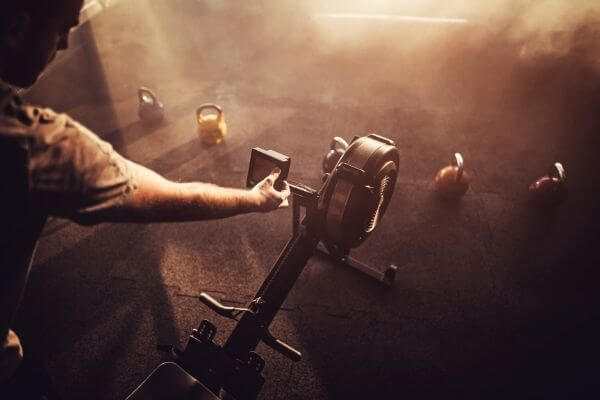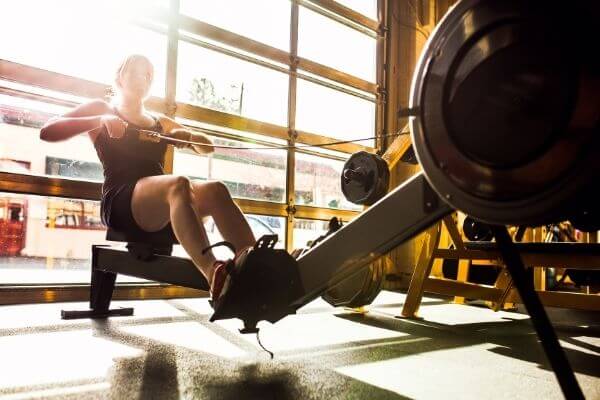Like any form of exercise, rowing and running will improve your heart health and make you feel better. But if you’re here, you’re probably wondering how to lose weight faster.
We’ll analyze objective data and subjective factors that influence your fat loss goal. We’ll also offer lots of tips in the process so that you can choose the proper workout for your needs.
Keep reading below!
Table of Contents
Rowing Vs. Running Cardio Intensity

Rowing and running are both excellent exercises for cardiovascular health. In one study, scientists proved that rowing is better than cycling for improving your heart health. The measured indicators were people’s heart rate (HR), stroke volume (SV), and cardiac output (CO).
Another study’s proved that rowing is beneficial for your heart even if you have certain chronic conditions.
And you can find lots of similar resources for running, such as here or here.
But the question remains:
Which form of exercise offers higher cardio intensity?
At the same exercise intensity, both exercises get your heart rate in the same ballpark. That’s because running at a 3/5 level implies some uphill and above-moderate speed, whereas rowing at a 3/5 level means increased resistance and faster strokes.
So, running uses speed to increase your heart rate, whereas rowing increases your heart rate through total-body effort.
And herein lies the secret:
When your heart rate reaches 160 bpm, you’ll feel more out of breath if you’re running than if you’re rowing. That’s because rowing uses your muscles more, whereas running pushes your lungs more.
Thus, you’ll feel that running is more challenging, although that’s not necessarily so.
Joint Impact

Rowing is friendlier on your joints than running. Particularly running on rocks or asphalt can damage your knees and ankles if you’re not wearing the right shoes.
On the other hand, rowing activates your lower body aches more, especially if you’re not keeping a good posture or if you have pre-existing lumbar pain.
But here’s the thing:
Because of its higher impact, running is a better weight-bearing exercise. That means it can strengthen your bones better in the long term, which helps you prevent – or even reverse – the effects of osteoporosis.
Rowing Vs. Running Calories
Studies show that rowing and running on the treadmill burn the same calories – about 500/ an hour of moderate-intensity exercise.
Still, running outdoors is different than running on the treadmill, and so is the comparison between rowers and treadmills.
But we digress.
Here’s the point:
These studies were made in a lab with limited participants with specific body compositions. Although the results offer valuable estimates, these figures are just ballparks.
Remember that your results will depend on your body and how hard you’re working. So, overweight, male, and young individuals will burn more calories than underweight, female, and older adults – even at lower intensities.
Of course, people with specific metabolic issues may burn fewer calories.
Besides:
We already explained why rowing feels less intense than running, even at the same intensity. So technically, you can push yourself harder when you’re rowing because it feels more manageable.
Conversely:
You can push yourself harder when you’re running because it’s easier to stay focused outdoors. For example, you won’t slow down if you know you’re getting from point A to point B in 30 minutes. But, if you’re rowing while watching a TV show, you can decelerate your movements.
So that’s all very subjective.
Still, if you want the cold numbers, running can burn 10-50 calories more per hour than rowing at the same intensity. The problem is those 50 calories represent tiny – just one square of chocolate or half a banana.
Weight Loss

Running technically helps you lose weight faster because those 50 calories/ hour will add up.
But here’s the thing:
- If you’re burning 500 calories/ hour on a rower, you’ll need 7 hours to shed a pound.
- If you’re burning 550 calories/ hour running, you’ll need 6.36 hours to shed a pound.
So, the two intervals are pretty similar.
Of course, if you want to twenty or thirty pounds, those intervals will get larger. So, you’ll save more time if you’re running.
Right?
Here’s the thing:
Weight loss is very subjective and also depends on other factors.
For example:
- You may row for longer because rowing has a perceived lower intensity than running.
- You may like one activity more, so you’ll be tempted to do that for longer and more often.
Warning: Pushing yourself too hard is damaging for weight loss. Excessive cardio leads to weight gain because it slows down your metabolism and damages your muscles, including your heart.
So:
If you’re planning to overexert yourself with running to lose weight faster, don’t.
Rowing is better for long-term weight loss because it also tones your muscles so you can keep up this sustained weight shedding. Alternatively, if you like running, remember to pace yourself and incorporate strength training into your routine.
We’ll explain why below:
Rowing Vs. Running Fat Loss
Fat loss is arguably more important than weight loss for your health and appearance goals. Skinny fat doesn’t look as good as a toned body – and it’s also not healthier.
So: rowing increases your muscle mass.
That affects your body composition because toned muscles help your body burn through its fat stores.
And that means you’ll burn more fat with rowing than with running.
Pro tip: Incorporate strength training to increase muscle mass if you choose running over a rowing machine.
Warning: Try not to use free weights when you’re running if you’re a beginner.
In this article about “Rowing Machine Vs. Treadmill,” we argued that you could use resistance bands or free weights during your exercise.
However, weights are safer when you’re walking on a treadmill than running because you won’t make jerking motions. Besides, a treadmill with built-in resistance bands has specific workout programs that teach you to use those bands safely. Some treadmills feature upper-body targeted workouts, too, where you can use your free weights.
Muscle Gain

Rowing increases your muscle gain compared to running, especially in your upper body. An interesting study shows significant improvements in back strength for people with scoliosis after six weeks of training.
So, rowers are better for arm and back strength.
What about lower body strength?
Rowing takes the cake here, too, because pushing and pulling on that rower works out your legs comprehensively. By comparison, running doesn’t target your inner and outer thighs as much. Running focuses more on your quads, hamstrings, glutes, and calves.
Conclusion
Both rowing and running are excellent tools for building cardiovascular health and losing weight. However, you can burn more calories and build more bone strength if you’re running. In turn, rowing can tone your muscles more and accelerate sustained fat loss.
Regardless of the exercise, you’re choosing, remember to listen to your body. Work out safely and choose the workouts that help you reach your goals faster, but be smart about it. Don’t overexert yourself and aim to build strength too.
- 7 Exercises for Pregnant Women in the First Trimester: Safe and Effective - January 30, 2025
- Our equipment recommendations - October 30, 2024
- Here’s What Doing Cardio Every Day Does To Your Body - August 21, 2024

